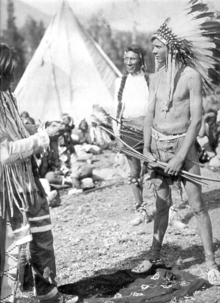Harry Behn
| Harry Behn | |
|---|---|
 | |
| Born |
September 24, 1898 McCabe, Arizona, United States |
| Died |
September 6, 1973 (aged 74) Greenwich, Connecticut, United States |
| Spouse(s) | Alice Lawrence (1905–1989) |
Harry Behn (September 24, 1898 – September 6, 1973), also known as Giles Behn, was an American screenwriter and children's author.
Early life
Harry Behn was born in 1898 in McCabe, Arizona, which is now a ghost town, in Yavapai County in what was then the Arizona Territory. He was the son of Henry K. Behn, an immigrant from Germany, and Maren (or Marion) Christensen Behn, an immigrant from Denmark.
At the age of 18, after he had been accepted as a student at Stanford University but before he went there, he met Henry Berger, a photographer affiliated with the Prizma Company, who hired Harry Behn as his assistant for the summer. The two of them went to Yellowstone and Glacier National Park, where they were supposed to take a series of nature slides for Prizma. A family emergency took Henry Berger away for a month, and during this time Harry Behn stayed in Glacier National Park with all the photographic equipment, waiting for Berger to return. While Berger was gone, Harry Behn made friends with some young Blackfoot Indians whose reservation was in the park, and lived with them. He was invited to join the tribe, and underwent all the tests and rituals involved in becoming a Blackfoot, and received the name Big Wolf Medicine. For a while he was actually listed as a Blackfoot with the Indian Service, making him eligible for oil royalties being paid to the Blackfoot tribe, and he actually received a check, but he later convinced the Indian Service to give the money to the tribe.[1]


He received his education at Stanford University, which he attended in 1918, and Harvard University (S.B., 1922).
Career as a screenwriter
Harry Behn was involved in writing the screenplay for a number of films, including the war film The Big Parade in 1925, and Hell's Angels in 1930, that was directed by Howard Hughes. The Big Parade, which was silent, would later be overshadowed by the success of All Quiet on the Western Front.
Academic career
In the mid-1930s, Harry Behn joined the faculty of the University of Arizona, where he was a professor of English and ran the educational radio programs. He founded and edited the Arizona Quarterly, and also founded the Phoenix Little Theater in the 1920s, and the University of Arizona Press in 1960.
Author
Harry Behn wrote many children's books, and also translated Japanese haiku, with the help of people who knew this language. His illustrated translation of the Duino Elegies by Rainer Maria Rilke was published by Peter Pauper Press in 1957.
Artist
Harry Behn also produced a number of paintings, although he is not as well known as an artist as he is as a writer. Some of his paintings are owned by his descendants.
Personal life
Harry Behn was married to Alice Lawrence (1905–1989), and had two sons Prescott Behn and Peter Behn, and one daughter Pamela Behn.
He died in Seville, Spain, while traveling there; his place of residence at the time of his death was Greenwich, Connecticut. He was 74 years old when he died.
Filmography
- The Big Parade (1925)
- Proud Flesh (1925), with Agnes Christine Johnson
- La Bohème (1926), with Ray Doyle
- The Crowd (1928), with King Vidor and John V.A. Weaver
- The Racket (1928), with Del Andrews
- Frozen River (1929)
- The Sin Sister (1929), with Andrew Bennison
- Hell's Angels (1930), with Howard Estabrook
- Secret of the Chateau (1934), with Richard Thorpe
Bibliography
- Siesta (poetry), Golden Bough, 1931
- The Little Hill, Harcourt, 1949.
- All Kinds of Time, Harcourt, 1950.
- Rhymes of the Times, under the pen name Jim Hill, published privately, 1950.
- Windy Morning, Harcourt, 1953.
- The House beyond the Meadow, Pantheon, 1955.
- The Wizard in the Well, Harcourt, 1956.
- Chinese Proverbs from Olden Times, Peter Pauper, 1956.
- (Translator and illustrator) Rainer Maria Rilke, Duino Elegies, Peter Pauper, 1957.
- The Painted Cave, Harcourt, 1957.
- Timmy's Search, Seabury, 1958.
- The Two Uncles of Pablo, Harcourt, 1959.
- Sombra (poetry), Christtreau, 1961.
- Roderick, Harcourt, 1961.
- (Translator) 300 Classic Haiku, Peter Pauper, 1962.
- (Translator, along with Peter Beilenson) Haiku Harvest: Japanese haiku. Series IV, Peter Pauper, 1962.
- The Faraway Lurs, World Publishing, 1963.
- (Translator) Cricket Songs: Japanese haiku, Harcourt, 1964.
- Omen of the Birds, World Publishing, 1964.
- The Golden Hive, Harcourt, 1957–1966.
- Chrysalis: Concerning Children and Poetry, Harcourt, 1949–1968.
- What a Beautiful Noise, World Publishing, 1970.
- (Translator) More Cricket Songs: Japanese haiku, Harcourt, 1971.
- Crickets and Bullfrogs and Whispers of Thunder: Poems and Pictures, edited by Lee Bennett Hopkins, Harcourt, 1949–1984.
- Trees: A Poem, illustrated by James Endicott, H. Holt (New York, NY), 1992.
- Halloween, illustrated by Greg Couch, North-South (New York, NY), 2003.
- The Grand Canyon: an ode, under the pseudonym Giles Behn, 150 copies published privately (date unknown).
Notes
- ↑ Behn Goebel, Alice Lawrence (1983[?]). Pamela Behn Adam, ed. Rememberings. pp. 33–34.
References
Book Poems: Poems from National Children's Book Week 1959–1998, page 26. Children's Book Council, 1998.
Contemporary Authors Online, Gale, 2003.
Rememberings, by Alice Lawrence Behn Goebel, edited by Pamela Behn Adam. Published privately, 1983[?].
St. James Guide to Children's Writers, 5th ed. St. James Press, 1999.
HARRY BEHN DEAD; AN EARLY SCENARIST (obituary on page 38 of the New York Times, Monday, September 10, 1973)
External links
|